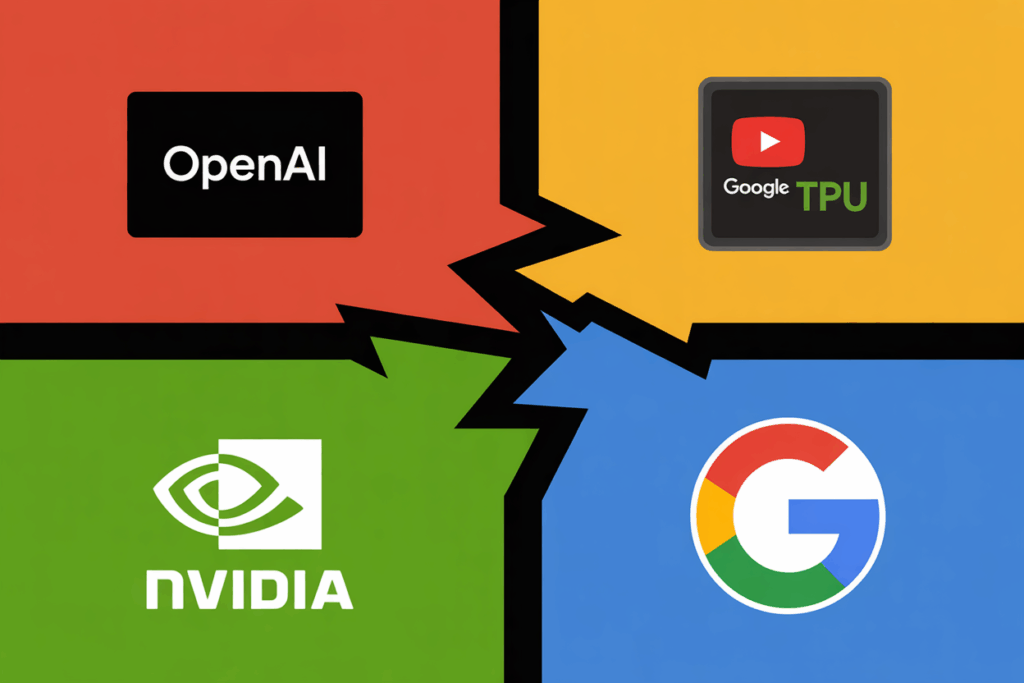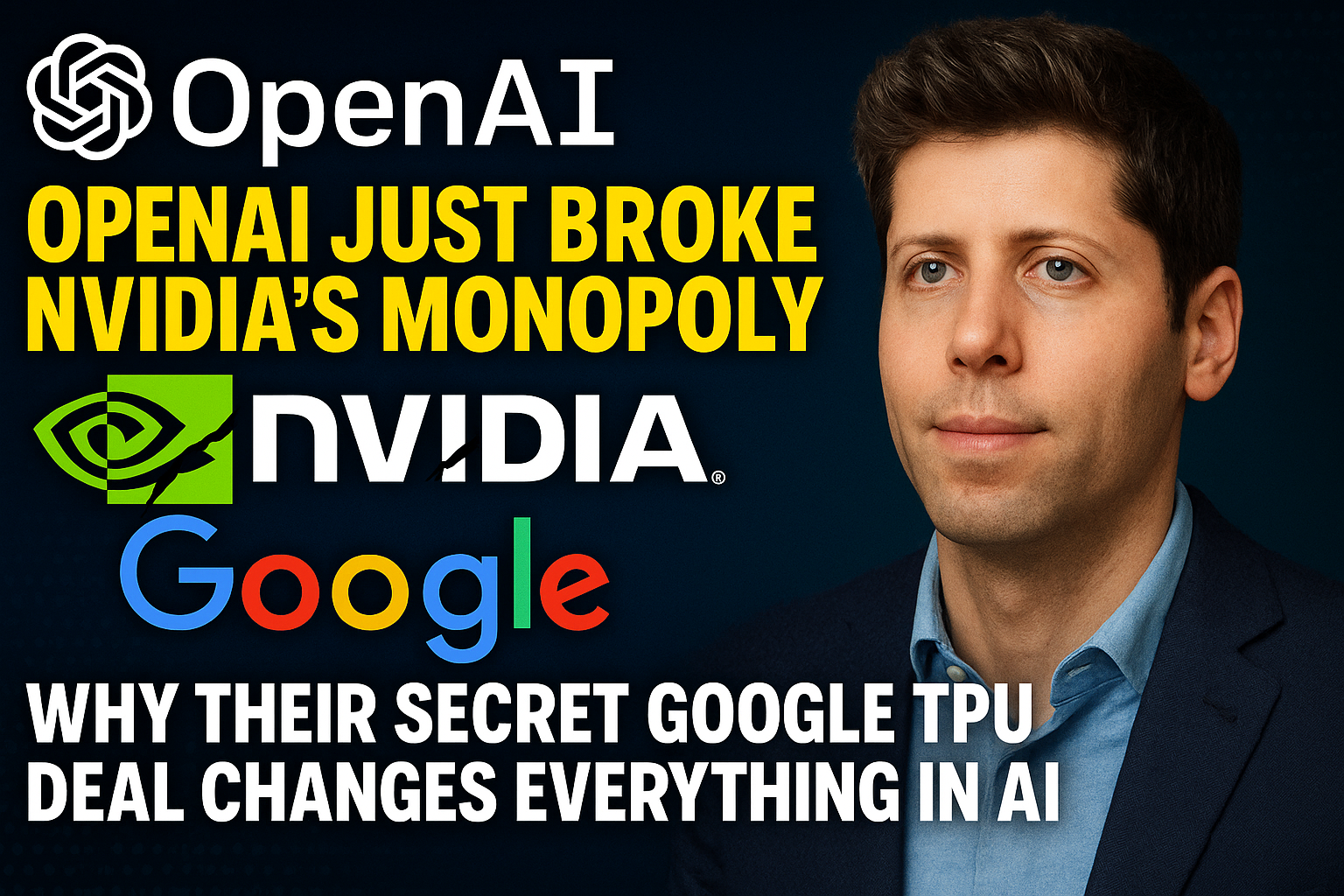Here's what nobody is talking about in Silicon Valley right now: OpenAI just made the most shocking move of 2025.
After years of exclusively relying on NVIDIA's expensive GPUs, Sam Altman's company has quietly started renting Google's TPU chips to power ChatGPT. This isn't just a business decision—it's a complete earthquake that's reshaping the entire AI infrastructure landscape.
I've been following this industry for years, and I can tell you that this move signals something bigger than just cost savings. It's OpenAI's declaration of independence from the NVIDIA-Microsoft ecosystem that has dominated AI for the past three years.

1. The $14 Billion Problem That Forced OpenAI's Hand
OpenAI is drowning in compute costs, and they needed a lifeline fast.
Here's the brutal reality: OpenAI spent more than $4 billion on AI servers last year, with training and inference costs each accounting for half, and expenditures on AI chip servers are expected to approach $14 billion by 2025.
That's not sustainable, even for a company that just hit a $10 billion annualized revenue run rate. When your compute costs are growing faster than your revenue, you need to make dramatic changes.
The breaking point came earlier this year when ChatGPT's image generation tool went viral. The explosive popularity of ChatGPT's image generation tool earlier this year put tremendous pressure on OpenAI's inference servers at Microsoft.
Suddenly, OpenAI realized they couldn't scale their business model without finding cheaper alternatives to NVIDIA's premium-priced H100 and A100 GPUs.
2. Google's TPU Strategy: The Anti-NVIDIA Play That's Actually Working
Google has been playing the long game with TPUs, and it's finally paying off.
For Google, the deal comes as it is expanding external availability of its in-house tensor processing units (TPUs), which were historically reserved for internal use.
This is brilliant strategy. For years, Google developed these chips exclusively for their own AI models. Now they're weaponizing them against NVIDIA by offering them to competitors at lower costs.
But here's the twist: Google, an OpenAI competitor in the AI race, is not renting its most powerful TPUs to its rival, The Information said, citing a Google Cloud employee.
Google is smart enough to help OpenAI reduce costs while keeping their newest Ironwood TPU v7 chips for their own Gemini models. It's competitive cooperation at its finest.
3. The Microsoft Breakup: OpenAI's Multi-Cloud Independence Strategy
This TPU deal is just the latest chapter in OpenAI's calculated breakup with Microsoft.
The move to rent Google's TPUs signals the first time OpenAI has used non-Nvidia chips meaningfully and shows the Sam Altman-led company's shift away from relying on backer Microsoft's data centers.
Think about this: Microsoft invested billions in OpenAI and has been their exclusive cloud provider since the beginning. Now OpenAI is diversifying across Google Cloud, Oracle's Stargate project, and CoreWeave.
This isn't just about technology—it's about power. OpenAI doesn't want to be dependent on any single partner, even one that helped build them.
The numbers tell the story: ChatGPT's paid subscribers have grown from 15 million at the beginning of the year to over 25 million, along with hundreds of millions of free users each week. That scale demands infrastructure independence.
4. NVIDIA's Worst Nightmare: The Alternative Chip Revolution
NVIDIA's GPU monopoly is finally cracking, and OpenAI just delivered the biggest blow yet.
For the past three years, if you wanted to train or run AI models at scale, you had one choice: NVIDIA. Their H100s became the gold standard, commanding premium prices and creating massive supply constraints.
But now? NVIDIA's high prices and short supply of its GPUs have opened up a market for alternative chips that can offer users lower costs.
The domino effect is already starting:
- Apple uses Google TPUs for Apple Intelligence training
- Safe Superintelligence (founded by former OpenAI chief scientist Ilya Sutskever) runs on Google TPUs
- Anthropic leverages Google's infrastructure
- Even Meta is reportedly considering TPUs
When the industry's biggest players start moving away from NVIDIA, it signals a fundamental shift in AI infrastructure.
5. The Inference Economics: Why TPUs Make Perfect Sense for ChatGPT
OpenAI isn't just experimenting—they've found the perfect use case for Google's specialized chips.
Through Google Cloud, OpenAI is renting Google's tensor processing units (TPUs) with the aim of cutting the costs associated with inference computing, the execution of models after training is completed.
Here's why this matters: Training AI models is one thing, but running billions of ChatGPT queries every day is where the real costs add up. Inference requires different optimizations than training.
Google's latest Ironwood TPU v7 chips are specifically designed for inference workloads. They're more energy-efficient and cost-effective for the type of processing ChatGPT does millions of times per day.
This isn't about replacing NVIDIA entirely—it's about using the right chip for the right job.
6. The Competition Heats Up: Why Every Cloud Provider is Fighting for AI Customers
OpenAI's multi-cloud strategy is forcing every major tech company to innovate or get left behind.
Look at what's happening across the industry:
- Amazon is pushing their Trainium and Inferentia chips through AWS
- Microsoft is developing Maia 100 chips (though they're facing delays)
- Google is opening up TPU access to external customers
- Oracle is building massive GPU clusters for Stargate
Since ChatGPT burst onto the scene in late 2022, OpenAI has dealt with increasing demand for computing capacity - known in the industry as compute - for training large language models, as well as for running inference.
The compute demand is so massive that it's reshaping entire cloud business models. Every provider wants a piece of the AI infrastructure pie, and they're willing to offer competitive pricing to get it.
7. What This Means for the Future of AI Development
OpenAI's TPU adoption is accelerating a trend that will define the next phase of AI development.
We're moving from a world where one chip type dominated everything to specialized silicon for specific AI workloads. Training models will use different chips than running inference. Different model architectures will favor different hardware.
This democratizes AI development. When NVIDIA was the only game in town, only companies with massive budgets could compete. Now, startups and mid-size companies have more options for cost-effective AI infrastructure.
Companies are prioritizing specialized silicon tailored to specific AI needs over one-size-fits-all solutions.
The ripple effects will be huge: faster innovation, lower barriers to entry, and more diverse AI applications across industries.
Final Results: The Numbers That Tell the Real Story
Let me put this in perspective with some hard data:
- Before: OpenAI spent $4+ billion annually on NVIDIA-based infrastructure with costs growing unsustainably
- After: Multi-cloud strategy across Google TPUs, Microsoft Azure, Oracle Stargate, and CoreWeave providing cost optimization and independence
- Market Impact: Alphabet stock jumped 2.1% on the news while Microsoft dropped 0.6%
- Scale Achievement: ChatGPT now serves 25+ million paid users and hundreds of millions of free users weekly
This partnership proves that even the biggest AI companies are prioritizing cost efficiency and infrastructure independence over vendor loyalty.
Conclusion: The AI Infrastructure Revolution Has Officially Begun
OpenAI's decision to embrace Google TPUs isn't just a business move—it's the shot heard around Silicon Valley that signals the end of NVIDIA's unchallenged dominance.
We're entering a new era where AI companies will choose specialized chips optimized for their specific workloads rather than defaulting to general-purpose GPUs. Cost efficiency, not raw power, will drive infrastructure decisions.
For entrepreneurs and developers, this means more options, better pricing, and lower barriers to building AI applications. For investors, it means the AI infrastructure market is about to get a lot more competitive and interesting.
The question isn't whether this trend will continue—it's which companies will adapt fast enough to thrive in this new multi-chip, multi-cloud AI ecosystem.
Are you ready to rethink your AI infrastructure strategy? Because OpenAI just showed you exactly how to break free from vendor lock-in and build a more cost-effective, scalable AI business.


